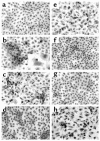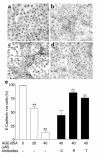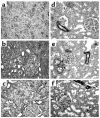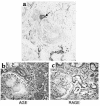Advanced glycation end products cause epithelial-myofibroblast transdifferentiation via the receptor for advanced glycation end products (RAGE)
- PMID: 11748269
- PMCID: PMC209461
- DOI: 10.1172/JCI11951
Advanced glycation end products cause epithelial-myofibroblast transdifferentiation via the receptor for advanced glycation end products (RAGE)
Abstract
Tubulointerstitial disease, a prominent phenomenon in diabetic nephropathy, correlates with decline in renal function. The underlying pathogenic link between chronic hyperglycemia and the development of tubulointerstitial injury has not been fully elucidated, but myofibroblast formation represents a key step in the development of tubulointerstitial fibrosis. RAGE, the receptor for advanced glycation end products (AGEs), induces the expression of TGF-beta and other cytokines that are proposed to mediate the transdifferentiation of epithelial cells to form myofibroblasts. Here we report specific binding of (125)I-AGE-BSA to cell membranes prepared from a rat proximal tubule cell line and show that the binding site was RAGE. AGE exposure induced dose-dependent epithelial-myofibroblast transdifferentiation determined by morphological changes, de novo alpha smooth-muscle actin expression, and loss of epithelial E-cadherin staining. These effects could be blocked with neutralizing Ab's to RAGE or to TGF-beta. Transdifferentiation was also apparent in the proximal tubules of diabetic rats and in a renal biopsy from a patient with type 1 diabetes. The AGE cross-link breaker, phenyl-4,5-dimethylthiazolium bromide (ALT 711) reduced transdifferentiation in diabetic rats in association with reduced tubular AGE and TGF-beta expression. This study provides a novel mechanism to explain the development of tubulointerstitial disease in diabetic nephropathy and provides a new treatment target.
Figures












Similar articles
-
Myofibroblast transdifferentiation of mesothelial cells is mediated by RAGE and contributes to peritoneal fibrosis in uraemia.Nephrol Dial Transplant. 2006 Sep;21(9):2549-55. doi: 10.1093/ndt/gfl271. Epub 2006 Jun 6. Nephrol Dial Transplant. 2006. PMID: 16757496
-
Advanced glycation end products induce tubular epithelial-myofibroblast transition through the RAGE-ERK1/2 MAP kinase signaling pathway.Am J Pathol. 2004 Apr;164(4):1389-97. doi: 10.1016/S0002-9440(10)63225-7. Am J Pathol. 2004. PMID: 15039226 Free PMC article.
-
Metformin inhibits advanced glycation end products (AGEs)-induced renal tubular cell injury by suppressing reactive oxygen species generation via reducing receptor for AGEs (RAGE) expression.Horm Metab Res. 2012 Nov;44(12):891-5. doi: 10.1055/s-0032-1321878. Epub 2012 Aug 3. Horm Metab Res. 2012. PMID: 22864903
-
Tubular epithelial-myofibroblast transdifferentiation mechanisms in proximal tubule cells.Curr Opin Nephrol Hypertens. 2003 Jan;12(1):25-9. doi: 10.1097/00041552-200301000-00005. Curr Opin Nephrol Hypertens. 2003. PMID: 12496662 Review.
-
AGE-RAGE and AGE Cross-link interaction: important players in the pathogenesis of diabetic kidney disease.Horm Metab Res. 2005 Apr;37 Suppl 1:26-34. doi: 10.1055/s-2005-861360. Horm Metab Res. 2005. PMID: 15918107 Review.
Cited by
-
Pancreatic cancer stromal biology and therapy.Genes Dis. 2015 Jun 1;2(2):133-143. doi: 10.1016/j.gendis.2015.01.002. Genes Dis. 2015. PMID: 26114155 Free PMC article.
-
Rap1a Overlaps the AGE/RAGE Signaling Cascade to Alter Expression of α-SMA, p-NF-κB, and p-PKC-ζ in Cardiac Fibroblasts Isolated from Type 2 Diabetic Mice.Cells. 2021 Mar 4;10(3):557. doi: 10.3390/cells10030557. Cells. 2021. PMID: 33806572 Free PMC article.
-
Immunohistochemical characterization of fibroblast subpopulations in normal peritoneal tissue and in peritoneal dialysis-induced fibrosis.Virchows Arch. 2004 Mar;444(3):247-56. doi: 10.1007/s00428-003-0963-3. Epub 2004 Jan 29. Virchows Arch. 2004. PMID: 14749928
-
Dapagliflozin Attenuates Renal Tubulointerstitial Fibrosis Associated With Type 1 Diabetes by Regulating STAT1/TGFβ1 Signaling.Front Endocrinol (Lausanne). 2019 Jul 3;10:441. doi: 10.3389/fendo.2019.00441. eCollection 2019. Front Endocrinol (Lausanne). 2019. PMID: 31333586 Free PMC article.
-
The Role of Advanced Glycation End Products in Aging and Metabolic Diseases: Bridging Association and Causality.Cell Metab. 2018 Sep 4;28(3):337-352. doi: 10.1016/j.cmet.2018.08.014. Cell Metab. 2018. PMID: 30184484 Free PMC article. Review.
References
-
- Brownlee M, Vlassara H, Cerami A. Nonenzymatic glycosylation and the pathogenesis of diabetic complications. Ann Intern Med. 1984;101:527–537. - PubMed
-
- Soulis-Liparota T, Cooper M, Papazoglou D, Clarke B, Jerums G. Retardation by aminoguanidine of development of albuminuria, mesangial expansion, and tissue fluorescence in streptozocin-induced diabetic rat. Diabetes. 1991;40:1328–1334. - PubMed
-
- Neeper M, et al. Cloning and expression of a cell surface receptor for advanced glycosylation end products of proteins. J Biol Chem. 1992;267:14998–15004. - PubMed
MeSH terms
Substances
LinkOut - more resources
Full Text Sources
Other Literature Sources
Medical

